Discover Shibamata, Tokyo's Charming Retro District: 12 Things to Do

Shibamata, Tokyo's retro town bursting with Showa-era charm, is a must for those who love tranquil gardens, Edo streets, and retro-style shops and cafes. Famous for its association with the heartwarming Japanese movie series "It's Tough Being a Man," Shibamata offers plenty to discover.
Explore Shibamata

Photo by Pixta
Shibamata is a charming retro town full of beautiful scenery and Edo charm, situated in Tokyo's Katsushika ward. An iconic shitamachi (low-lying district of Tokyo), Shibamata is famous for being the hometown of Tora-san, a comedic character from the heartwarming Japanese movie series "It's Tough Being a Man."
Showcasing the series with pride, Tora-san can be spotted throughout the town, from shop merchandise to dedicated museums. The series made history by achieving the Guinness World Record for the longest-running movie series with a single actor. Greeting visitors at Shibamata Station are statues of Tora-san and his love interest, Keiko Kishi. Frozen in time, the famous characters seem ready to part ways once again as the traveling salesman heads off for another journey.
A hidden gem, Shibamata is a perfect day trip for those in Tokyo, offering museums, tranquil gardens, tea houses, art, traditional Japanese cuisine, snacks, and more!
12 Fun Things to Do in Shibamata
1. Taishakuten Sando Street
2. Shibamata Taishakuten Temple and Suikeien Garden
3. Haikara Yokocho
4. Toy Museum
5. Yamamoto-tei: Green Tea and Sweets
6. Machi-no-Eki Fantasia Cafe
7. Tora-san Museum and Cafe
8. Yamada Yoji Museum
9. Retro Cafe Sepia
10. Katsushika Iris Festival
11. Hotels in and around Shibamata
12. Yagiri-No-Watashi: River Crossing Boat
Read also
1. Taishakuten Sando Street

Photo by Pixta
Taishakuten Sando is a 200-meter-long approach leading to Taishakuten Temple, lined with local shops offering Japanese sweets, snacks, and cuisine! Enticing guests from Shibamata Station, this street is popular among locals and visitors, offering beautiful scenery and an array of delicious Japanese dishes along its nostalgic, retro pathways.
The incredible atmosphere along Taishakuten Sando is hard to match in Tokyo, preserving its historical charm. Friendly locals create a comfortable environment in this small, humble town, so much so that it’s hard to believe that Shibamata is located in the largest city in the world.

Photo by Pixta
One of the most popular shops is Kameya Honpo, a mouthwatering dango shop selling an array of flavors. The store also has a restaurant for those who wish to dine in the area.
Other street food delicacies include rice crackers, dorayaki, kuzu-mochi, kusa mochi, yokan, and croquettes, as well as restaurants selling traditional Japanese dishes such as soba, unagi, and sashimi.
Spectacular at all hours, visitors can enjoy the bustling street food during the day, golden sunsets in the afternoon, and the hauntingly beautiful lantern-lit pathways at night.
Taishakuten Sando website: http://shibamata.net/eng/
2. Shibamata Taishakuten Temple and Suikeien Garden

Photo by Pixta
At the end of Taishakuten Sando, is the town's sacred treasure and centerpiece, Shibamata Taishakuten. Greeting visitors is the gigantic Nitenmon Gate, a grand wooden structure built in 1896 by Master Sakata, a carpenter known as the last master of Edo architecture.
The gate features two Buddhist deities on each side of the path and intricate carvings spanning across the doors and archway of the two-story installation.

Photo by Pixta
Beyond the gate lies Shibamata Taishakuten, a temple established in 1629 and restored in the early 20th century. The temple complex consists of various structures and a beautiful Japanese garden.
A 500-year-old pine tree sprawls across the temple pathway, representing a dragon. The mythical creature arches above the hall's doors, acting as a protector and guide of Shibamata's sacred temple.

Photo by Pixta
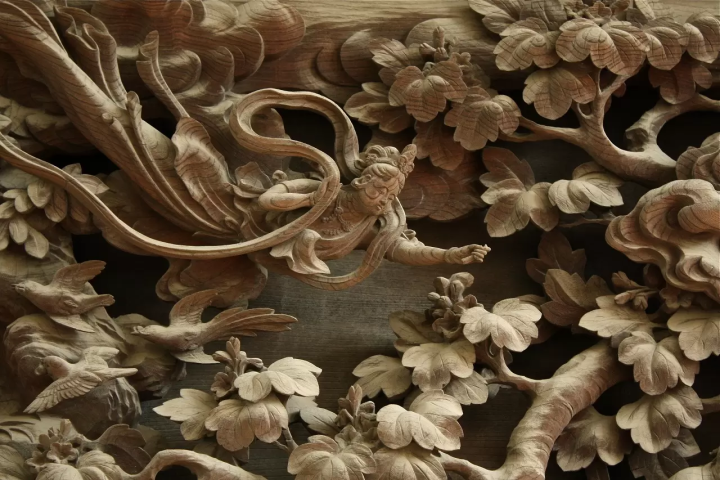
Photo by Pixta
The exterior of the temple's main building is decorated with mesmerizing wooden carvings depicting scenes from Buddhist scriptures. For a small fee, you can access the entire gallery. The craftsmanship behind these carvings will leave you in awe!

Photo by Pixta
Behind the temple is Suikeien, a Japanese garden created in 1965. Brimming with greenery, the garden adds splashes of nature's brilliant colors to the temple grounds, featuring flowers, pine trees, rocks, and koi carp swimming peacefully in a pond.
Guests can wander through wooden corridors, winding bridges, and tatami-filled rooms surrounded by nature, all displaying magnificent views of the garden. Free tea is available at the Grand Guest Hall, perfect for those who wish to relax and refresh.
Shibamata Taishakuten
Location: 7 Chome-10-3 Shibamata, Katsushika City, Tokyo Map
Website: http://www.taishakuten.or.jp/index.html
3. Haikara Yokocho


Photo by Pixta
Situated near Shibamata Station on Taishakuten Sando, is Haikara Yokocho, a traditional sweet shop!
Packed with retro goods, the store sells brightly colored candy and merchandise, as well as colorful children's toys and black-and-white photocards of popular Showa era (1926-1989) actors and singers.

Photo by Pixta
Flashing pinball machines, arcades, and a fun carnival shooting game where you can win amusing prizes fill the environment with nostalgic delight, adding a unique twist to the shop.
Official Website: http://www2.odn.ne.jp/shibamata/
4. Toy Museum

Photo by Pixta
A retro video game lover's paradise, Shibamata’s Toy Museum is bursting with colorful arcade games, creating a building full of fun displays and wacky designs!
The museum is located above Haikara Yokocho and offers guests the opportunity to discover popular miscellaneous goods and play retro arcade games.

Once a popular town for selling toys, Shibamata used to be brimming with candy stores that sold goods for children, so much so that there were more candy stores than convenience stores! Katsushika Ward was well known for its toy makers and toy shops during the Showa period (1926-1989).
To preserve this part of Shibamata's unique history, the Toy Museum was created, recreating a space that allows guests to become immersed in the town's history while having fun. Alongside its arcade games, the museum features a cozy replica of a small family restaurant, frozen in time, with decorated walls showcasing rare collectibles.
To access the museum, use the building’s outside stairs near the robot vending machine. The museum charges 200 yen per person.
5. Yamamoto-tei
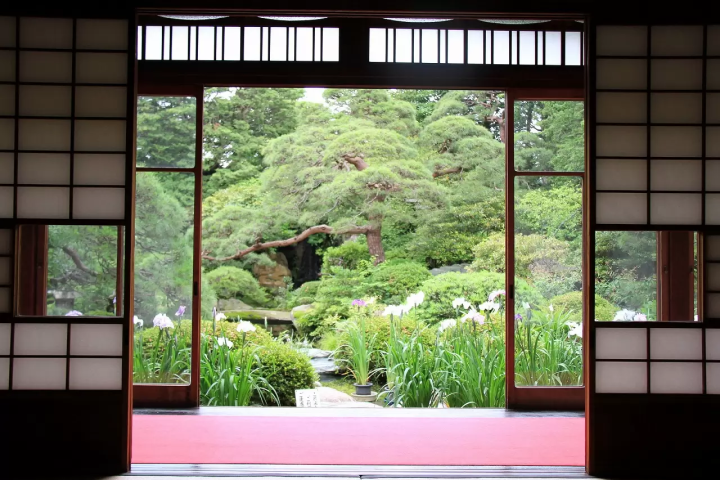
Photo by Pixta
Yamamoto-tei is a tranquil tea house where visitors can unwind while enjoying delicious traditional sweets alongside rich matcha tea with garden views. Situated only five minutes away from Taishakuten, the tea house resides in a tranquil garden that changes colors from season to season.

Visitors can experience a different atmosphere at the tea house throughout the year, from autumn-leaved gardens and heated rooms to open sliding windows in summer, looking out onto green foliage while incense burns from pig-shaped burners.

Merging Japanese and Western architecture, Yamamoto-tei is a great example of Taisho (1912-1926) and Showa period historical architecture and design.
Decked out with tatami mats, sliding doors, carved wooden panels, and hallways, the building was originally built as a home for Einosuke Yamamoto, the creator of the camera manufacturer Yamamoto Factory. The tea house was relocated to Shibamata after the Great Kanto Earthquake (1923) and served as a residential home for four generations before opening its doors to the public.
You can explore the house’s architecture and order delicious hot and cold beverages and desserts, such as sweet seasonal wagashi. While waiting for their food, visitors can unwind and marvel at koi fish gently swimming in the beautiful traditional Japanese garden.
Yamamoto-tei
Location: 7 Chome-19-32 Shibamata, Katsushika City, Tokyo MAP
Official Website: https://www.katsushika-kanko.com/yamamoto/
6. Machi-no-Eki Fantasia Cafe

Just around the corner from Yamanote-tei is Machi-no-Eki Fantasia Cafe, serving flavorful meals and snacks.
Warm and welcoming, the cafe offers jobs to those with disabilities and creates a safe, peaceful environment for its workers and guests, making it an amazing and supportive place to stop by and refresh.
The cafe provides an English menu featuring its mouth-watering cuisine. Visitors can choose from delicious sandwiches and toast, as well as tasty meals such as pasta and curry rice.
Those with a sweet tooth won't be disappointed! Machi-no-Eki Fantasia offers beautiful parfaits, hot pancakes, zenzai desserts, and more, serving colorful shaved ice to cool you down in summer.
Machi-no-Eki Fantasia Cafe
Location: 7 Chome-9-16 Shibamata, Katsushika City, Tokyo Map
Official Website: https://www.ohzorakai.com/machinoeki.html#shien_b02
7. Tora-san Museum and Cafe

Photo by Pixta
At the Tora-san Museum, an immersive experience awaits as you enter the world of Tora-san and explore Shibamata during the Showa period! Upon arrival, guests are greeted by a room adorned with digital murals, depicting scenes of Tora-san alongside music. Brimming with art, sets, and everything related to Tora-san, the museum is a must for fans and lovers of Shibamata.
Memorable, nostalgic items and props decorate the museum's interior, such as Tora-san’s suitcase and hat, as well as an iconic location from the franchise—the famous dumpling shop, Kurumaya, a spot frequently visited in the series and run by Tora-san's stepsister.
Visitors can experience the comedic and lovable main characters' journeys through entertaining installations, from Tora-san’s beloved slow train journey—a recreation of a train car that displays nostalgic scenes from the movie—to Shibamata Station, frozen in time from the Shōwa period.

Photo by Pixta
Other sets include miniature models, a moving diorama that tells the story of Tora-san's life from childhood to his adventures as an adult, photo spots, and a recreation of the Taishakuten Sando streets in the 1950s.
If you are a fan of the Showa period, "It’s Tough Being a Man," or simply wish to see another side of Shibamata, we highly recommend taking a nostalgic trip down memory lane and stopping by the Tora-san Museum during your travels.
After exploring the heartwarming and homely scenes in the museum, why not head next door to the retro Tora-san Cafe and indulge in delicious cakes, drinks, and cuisine?
Tora-san Museum
Location: 6 Chome-22-19 Shibamata, Katsushika City, Tokyo Map
Official Website: https://www.katsushika-kanko.com/tora/
8. Yamada Yoji Museum

Photo by Pixta
Next door to the Tora-san Museum is a museum dedicated to the director of the beloved series. Included as part of the Tora Museum ticket, guests can learn about one of Japan's leading filmmakers, Yamada Yoji, along with his work, inspiration, history, and passions.
Debuting as an assistant director with "The Stranger on the Second Floor," Yamada Yoji went on to direct popular films and TV shows such as "Yellow Handkerchief of Happiness," "Family Is Tough," "The Twilight of Seibei," and, of course, "It's Tough Being a Man."
With a strong passion for creating movies that touch people's hearts, the director has produced many heartwarming series that resonate with those who have faced hardships, often featuring recurring themes of family and happiness.
Within the museum, different sections explain his works and the meanings behind his creations, as well as reflections on Japan's economy, education, and the director's career, which is showcased in the cinema room. A special section dedicated to Kiyoshi Atsumi, the actor who played Tora-san and a friend of Yamada Yoji, is displayed in his memory.
Visitors can see up close equipment once used to film and edit famous movies from the Shochiku Ofuna Studio, where the director worked, as well as some of his recent work, such as his first historical drama trilogy, which tells the story of a samurai.
Yamada Yoji Museum
Location: 6 Chome-22-19 Shibamata, Katsushika City, Tokyo Map
Official Website: https://www.katsushika-kanko.com/yamada-yoji-museum/index.html
9. Retro Cafe Sepia
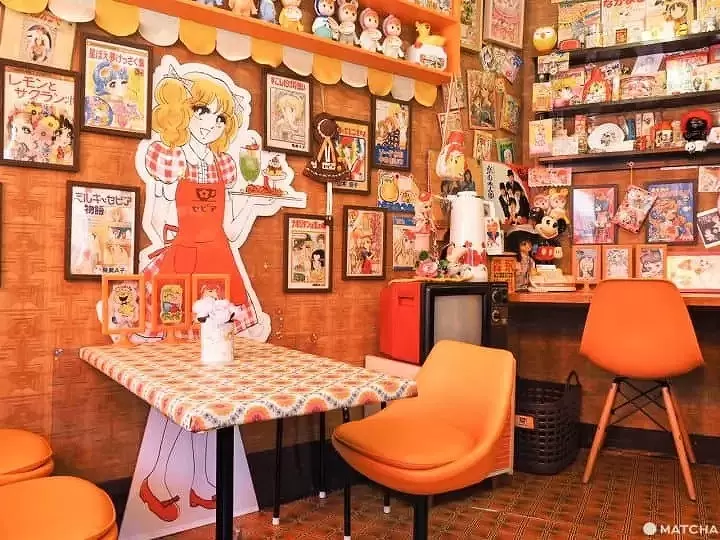
Enter the world of Showa-era manga comics at Retro Cafe Sepia! Created by manga enthusiast Ms. Hasezawa, whose dream was to create her own coffee house, Sepia is brimming with nostalgia and memories from Japan's '70s, featuring colorful collectibles and warm orange and pink interiors, along with fun desserts and dishes!
The cafe's welcoming and colorful designs create a paradise for fans of retro shōjo manga and anime, displaying multiple themed rooms, each with a unique expression in mind.
Visitors can explore a teenage girl's bedroom from the '70s, themed around the memories of a junior high school girl; the World’s Smallest Candy Candy Museum, featuring collectibles from the popular '70s manga Candy Candy; and a Shōwa-style living room with a nostalgic feel, themed around hanging out at a friend’s house as a child.

Radiant and cheerful, the fun does not stop at the cafe’s interior! Adorable dishes full of charm can be ordered, such as vibrant cream soda floats and custard puddings with a cherry on top for dessert, as well as savory dishes like Napolitan spaghetti topped with an octopus-shaped sausage. To find out more about this hidden gem, check out our detailed article on Sepia.
10. Katsushika Iris Festival

Photo by Pixta
The Katsushika Iris Festival is a delightful event that takes place each June. Hundreds of irises paint Katsushika's gardens and riversides with royal purple flowers.
Irises can be found along Shibamata's riverside and in Yamamoto-tei's garden. If you are in the area during peak season, we highly recommend venturing a little further out to nearby towns to experience a flower paradise!
The festival's main locations, Mizumoto Park and Horikiri Shobuen, are not far from Shibamata, flourishing with thousands of irises that create jaw-dropping scenery.

Photo by Pixta
Mizumoto Park is Tokyo's largest iris festival venue, boasting 200,000 irises in June and located only a 13-minute bike ride or 23 minutes by train from Shibamata.
Mizumoto Park features a bird park, a BBQ area, a water creature museum, and a dog run. Many come here for outings with friends and family to enjoy nature in Tokyo's largest park, and during the iris festival, the grounds come to life with splashes of royal purple amidst winding streams and bridges.

Photo by Pixta
Horikiri Shobuen Iris Garden is a traditional Japanese-style garden created in the Edo period. Beautiful in summer due to its 6,000 purple irises, the garden inspired beautiful art pieces created by Ukiyo-e masters Utagawa Hiroshige and Utagawa Toyokuni.
Visitors will be met with stunning pink, white, and purple landscapes, featuring winding bridges that cross over the garden's large ponds. Just 26 minutes from Shibamata, Horikiri Shobuen Iris Garden is the perfect place to stop by before visiting the retro town. Situated along the Ayase River, the garden can be accessed in 30 minutes from Ueno Station.

Photo by Pixta
In the opposite direction of Mizumoto Park but just as beautiful is Koiwa Shobu Garden, a 14-minute bike ride or a 24-minute train ride from Shibamata Station.
Although not part of the Katsushika Iris Festival, the garden is a must-visit for those who love flowers. The riverside garden has around 100 types of iris species and 50,000 blooming iris flowers on its beautiful grounds, perfect for those who want to walk along the river and enjoy stunning views of flowers, water, and bridges.
11. Hotels in and around Shibamata

Photo courtesy of Booking.com
Shibamata is a quaint, small town populated by locals who have resided there for generations. The town still preserves its local charm and features, making hotels and inns somewhat limited.
However, Shibamata offers apartment-style accommodations that match the town's homely atmosphere, as well as houses and unique lodging options featuring beautiful artwork. There are also plenty of places to stay and explore around Katsushika Ward.
In this section, we will introduce five places you can stay in and around Shibamata.
Read also
1. Ukiyoan Takasago

Photo courtesy of Booking.com

Photo courtesy of Booking.com
Ukiyoan Takasago is a 14-minute walk from Shibamata Taishakuten and is located near Takasago Station, which connects directly to a variety of metro lines.
This vibrant apartment complex can host up to nine people and is a brilliant place to stay for those who love art and design. Boasting three floors, guests can enjoy family meals around a large table and admire murals displaying ukiyo-e artwork.
The apartment features a fully equipped kitchen, a washing machine, shower rooms, air conditioning, and free Wi-Fi, along with other essential amenities.
2. HIDAKA STAY VILLA Shibamata

Photo courtesy of Booking.com
Just a 3-minute walk away from the Toy Museum, the Hidaka Stay Villa Shibamata is an apartment featuring two floors and three bedrooms.
Guests can relax in a chic, modern living room and kitchen, as well as experience dining in a traditional Japanese tatami room with a low table and cushions to sit on, adorned with shoji sliding doors.
3. Murata Corpo
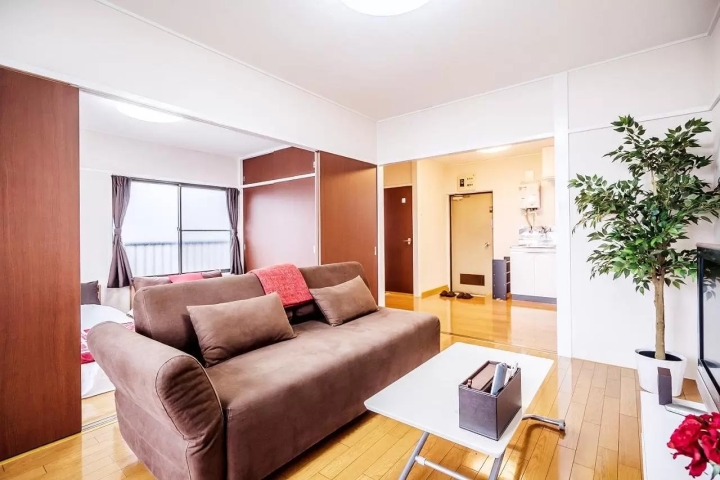
Photo courtesy of Booking.com
Murata Corpo is a building featuring two different apartment complexes to choose from. Both apartments have similar layouts and furnishings, including two beds, a sofa, a TV, a kitchen, and a shower room.
The apartments are ideal for those traveling as a couple or with friends who don’t want to rent an entire house while staying near the center of Shibamata.
4. Lodging Tokyo Shibamata

Photo courtesy of Booking.com
The closest accommodation to Shibamata Station, Lodging Tokyo is just a 4-minute walk from Shibamata Taishakuten. The lodge offers private rooms featuring tatami floors and futons for sleeping, as well as a TV, fridge, and shower room.
5. Shibamata Futen
Affordable and friendly, Shibamata Futen is an excellent choice for art lovers, couples, and those who wish to meet others on their adventures. Offering a variety of rooms and accommodation plans, Shibamata Futen has both private Western and Japanese-style rooms to choose from, along with a lounge area, a courtyard for socializing, a library, a laundry room, a shared kitchen, and shower rooms.
Colorful art murals decorate 14 rooms within the building, each created by a unique artist expressing their individual flair. The Shibamata to Art project was created to connect people with art and showcase a new side of Shibamata, providing a unique experience that leads to new discoveries. Check out the artists' charming artwork and see the variety of art rooms available by visiting the official website: http://art.shibamatafuten.com/
An entire floor, as well as the whole building, can be rented by groups and can be used as a training facility camp. Bikes are available, and we recommend that those who stay take a bike ride along the riverside!
Official Website: http://shibamatafuten.com/
12. Yagiri-No-Watashi

Photo by Pixta
A rare way to travel, Yagiri-No-Watashi is the last and only place in Tokyo where locals and visitors can travel across the city’s riverscape using a ferry boat. Once a popular tradition, ferry boats have gradually dwindled in Tokyo due to more convenient modes of travel and bridges connecting the city's districts.
Sailing back and forth from Shibamata's riverside to Yagiri in Chiba for 400 years, Yagiri No Watashi was chosen as one of the 100 places that represent life in Japan during the Heisei era and has been featured in Grave of the Fireflies as well as inspiring songs such as "Yagiri no Watashi" by Takashi Hosokawa.

Photo by Pixta
Originally used to connect farmers to villages, the boat is now used by the public, carrying up to 30 people. Costing 200 yen each way and taking approximately 10 minutes, it is said to be a relaxing ride.
The crossing is part of Japan's 100 Soundscapes, where people can experience the beautiful calls of nature and sounds over daily traffic and industrial noises.

Photo by Pixta
Travelers can either walk for 20 minutes to explore Matsudo City or head in the other direction to enjoy Yagiri's beautiful gardens and riverscape, such as Satomi Park, which flourishes each year with roses and cherry blossoms!
Enjoy Exploring Shibamata

Photo by Pixta
A relaxing place full of unique charm, Shibamata is the perfect destination to experience another side of Tokyo. The area connects to a wide variety of wonderful places, offering plenty of fascinating events to experience in the region.
For those visiting in summer, we highly recommend attending the Katsushika Noryo Fireworks and Edogawa Fireworks Festival (30 minutes from Shibamata via train) for dazzling displays along the Edogawa River!
Read also
Main image by Pixta
Assistant editor at MATCHA since 2023, Kate is a photographer who enjoys traveling Japan's hidden gems and adventuring off the beaten path. Living in Japan since 2018, she has traveled across different areas of Japan. From indulging in Aomori’s apple pies and fiery festivals to exploring the quaint charm of Nagasaki’s cat-filled streets she is always searching for new areas full of atmospheric beauty, festivals, and seasonal events to capture on camera.






























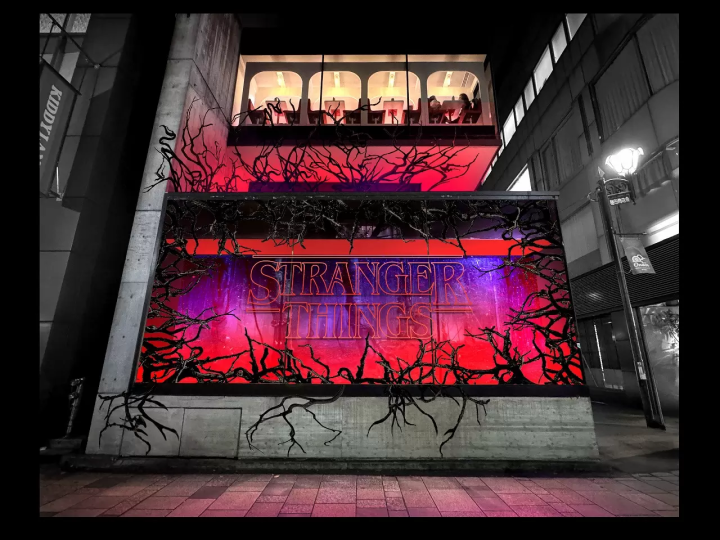






![[JR KYUSHU HOTEL Blossom Oita] A hotel directly connected to Oita Station - A comprehensive guide to access!](https://resources.matcha-jp.com/resize/720x2000/2025/10/23-247814.webp)

![Deep dive into Japanese brands! A tour of famous leather shoe stores with GENSEI & Nin [Harta Edition]](https://resources.matcha-jp.com/resize/720x2000/2025/12/18-253277.webp)
